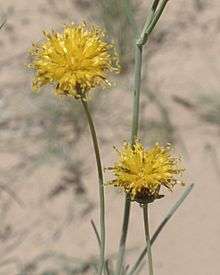Thelesperma megapotamicum
| Thelesperma megapotamicum | |
|---|---|
 | |
| Scientific classification | |
| Kingdom: | Plantae |
| (unranked): | Angiosperms |
| (unranked): | Eudicots |
| (unranked): | Asterids |
| Order: | Asterales |
| Family: | Asteraceae |
| Subfamily: | Asteroideae |
| Tribe: | Coreopsideae |
| Genus: | Thelesperma |
| Species: | T. megapotamicum |
| Binomial name | |
| Thelesperma megapotamicum (Spreng.) Kuntze | |
| Synonyms | |
|
Thelesperma gracile (Torr.) A.Gray | |
Thelesperma megapotamicum is a perennial species of flowering plant in the aster family known by the common name Hopi tea greenthread[1] and rayless greenthread. It is native to sections of the Americas, including the central United States, where it grows in many types of habitat. It is a perennial herb producing a slender, branching stem 30 to 60 centimeters tall or more. The leaves are narrow, mostly compound with linear or threadlike segments measuring a few centimeters long. The inflorescence bears several flower heads each in a cuplike involucre of phyllaries with purple-tinged, pointed lobes with white edges. The head contains many yellow or orange disc florets, and sometimes one or more yellow ray florets, although these may be absent.
Native American groups such as the Hopi and Navajo use this plant to make herbal teas, as a medicinal remedy and a yellow dye.[2]
References
- ↑ "Thelesperma megapotamicum". Natural Resources Conservation Service PLANTS Database. USDA. Retrieved 9 December 2015.
- ↑ Ethnobotany
Further reading
- Tso, Zoncho. "Medicinal Plants of the Southwest Thelesperma megapotamicum". New Mexico State University. Retrieved 26 February 2014.
- Yazzie, Shalene. "Thelesperma megapotamicum (Spreng.) Kuntze". Northern Arizona University. Retrieved 11 March 2014.
- Dharmananda, Subhuti. "GREENTHREAD: NAVAJO-HOPI TEA". Institute for Traditional Medicine. Retrieved 11 March 2014.